

The Central Radio Association , from the Rockies to the Ohio (top file)
by KØIP, my connection with this radio association is very
simple, My Grandfather became a member in 1916
I will present more about him and his history towards the bottom of the page , This page is
dedicated to the preservation of Amateur Radio history.
DO you have any
information about the Central Radio Ass'n. email johnwilson@k0ip.com KØIP
Thanks to input from many other hams, I have a little information about an
organization .. The Central Radio Association,
which unlike the ARRL
located back east were the population was concentrated the Central Radio
Association was out in the "Wild West"
well OK maybe it wasn't totally
wild in the early 1900's it was far less populated .... It was a
active organization of
experimenters interested in the NEW invention, RADIO
Fact: in July 1915 the ARRL the first QST was still 7 months from
publication .
From info in the ARRL book 200 meters and down, it's apparent
the Central Radio Ass'n was formed in 1911, Three years before the
ARRL.
There was a lot
of "arcing" and "sparking" going on out in the midwest.
This Certificate was my grandfathers, he lived in Shawnee Kansas.
Fremont Jones.. FJ issued 4 April 1916,
FJ's certificate was issued 1 year before the USA entered WW1. When the
war broke out Fremont Wilson Jones along
with his best friend Carl Goddard dropped out of high school and joined the Navy. FJ served on a troop ship making 23 trips
back and forth to Europe,
I'm not sure what Carl did in the war, apparently they joined together, and
wanted to serve together,
but got separated at boot camp..
I'm sure Carl was involved in FJ's early radio experiments, Carl
live in the next farmhouse
down the road.. about 1 mile from FJ,
This link takes you down the page for pictures of Fremont
CLICK for Pictures of FJ.
Might I add a comment, it appears that the federal government was
completely involved in licensing those early ""amateurs"" . this link will
take you to a web that has
lots of early documents with lists and lists of amateurs. IN FACT almost
mindless to me.. I mean WOW there were lots of folks playing with radios. most
were probably
using Spark Gap transmitter.. What a time in history it must have
been.
Here
is the latest addition to the collection, dated 28 July 1915 ,
AB, for Arnold Barta who lived in Cedar Rapids,
Iowa
its NUMBER 330. This certificate and the info about AB was
supplied by his Grandson Keith Farley WAØSVC .. ..
for a very interesting biography of Arnold this link will take
you down the page
Personal info about AB lots of his pictures below
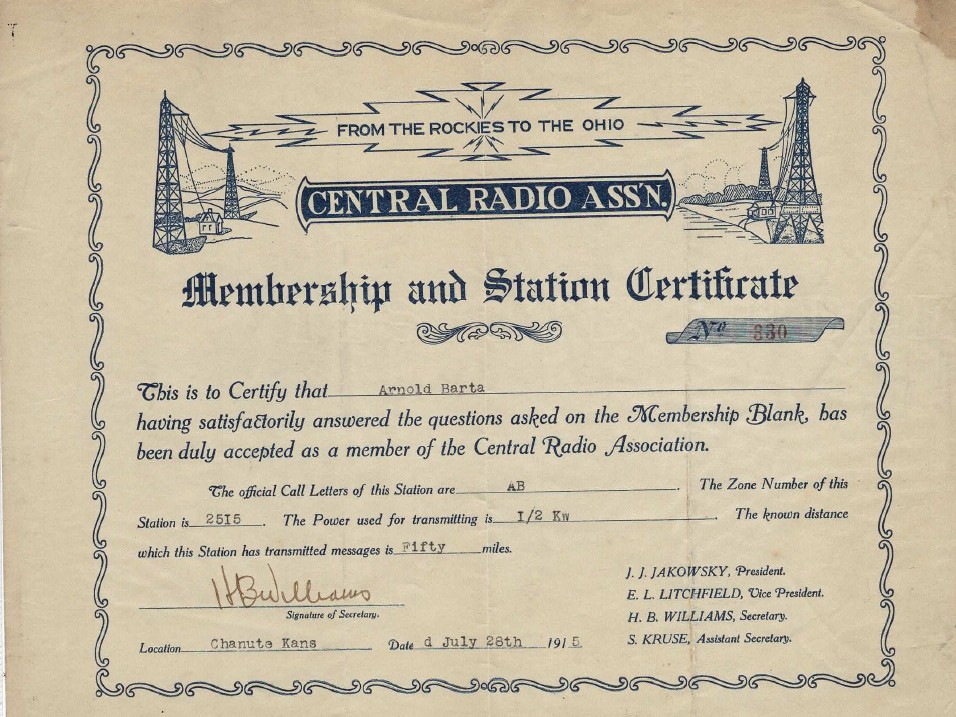
now
here's a certificate from 24 June 1915, Its the oldest one we have found,
NUMBER 309.. supplied by Dale WØHSK
it looks like Safford made some modifications to his certificate , I think the
original text was , a 4 inch coil and maybe
Twenty or Thirty miles distance .
I understand he lived in Topeka Kansas, and later became W9QV then W0QV..
Fact: a bit curious, they assigned him 9QV which might
have followed some sort of government scheme at the time ??
but on the two later
certificates "AB" and "FJ"
they appeared to have abandon that strategy ??
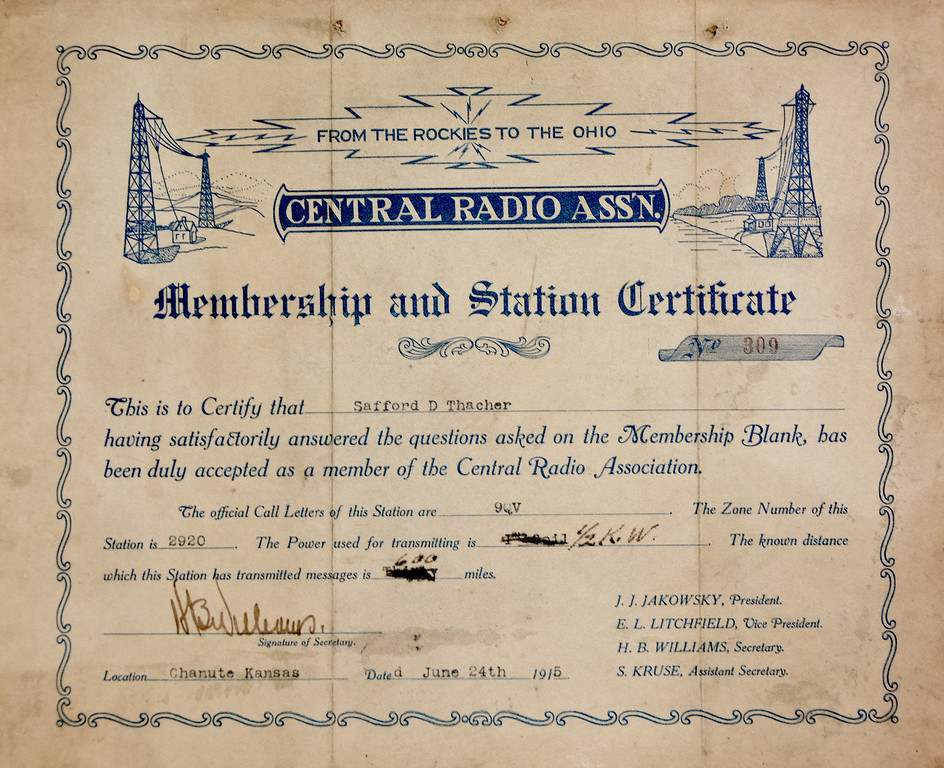
OK Guys, since I started looking for information , with your help, we have found out several
facts...
heres a paragraph from the ARRL book 200 meters and down. It says the
Central Radio Assn was formed in 1911.
info supplied by
Charlie KØTHN

from Glenn KFØED Here the link to the mention of Central
Radio in an old issue of The Popular Science Monthly, dated 1915.
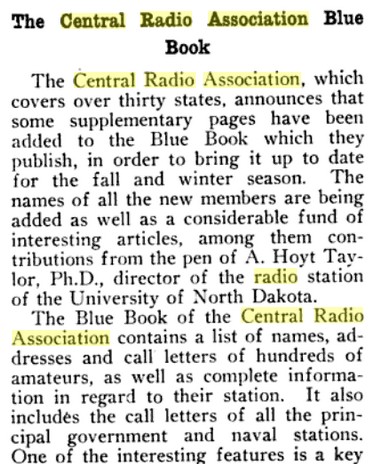

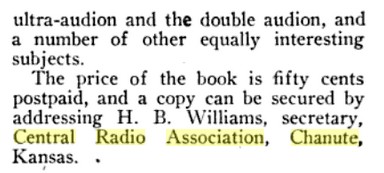
WOW, would I love to get a copy or PDF of this
Blue book ,
it would list a lot of radio pioneers !
Anyone having one please contact me,
Just below is personal info about my
grandfather FJ
and a bit further down the page is personal info about AB, supplied by his
Grandson Keith Farley WAØSVC
FJ,, Wilson Fremont Jones - Shawnee Kansas
Now if your interested , here's a short history about my (KØIP) Grandfather Wilson Fremont Jones
here are a few pictures of FJ, Wilson Fremont Jones sr. he went by
Fremont, he was my grandfather, he died when I was just a kid,
I really didn't know him at all, he lived in California and we lived in Shawnee,
Kansas.
Born November 25, 1898 in Olathe, Kansas at the Johnson County
Jail. Not because his mother was a criminal , but
because his father John Wilson Jones was the County Sheriff.
Their house was the front part of the jail. My great grandmother , his mother,
actually cooked and served dinner to the prisoners. (How things have changed)
He (FJ) died March 4, 1954 in California. Buried at Rosehill Memorial Park,
Whittier, California.
US Navy WW1, he was a gunner on the Great Northern (a ship) he made 23 trips
back and forth across the Atlantic, taking new troops over and
bringing home the wounded. After WW1 He was with the Kansas City, Missouri
Police Dept as a patrolman, motorcycle cop and a detective.
He quit the Police Dept because of the corrupt Pendergast regime in Kansas City.
Then , He was a salesman for Hall Brothers which
is now Hallmark Cards.
His territory was the state of Minnesota.
He later went to California where he was a car salesman. He also owned his own
Chrysler dealership in Whittier, California.
during WW2 he worked as a security guard at a defense plant in San Pedro .
| his wife Rose Ellen Kanally
Fremont Jones US Navy WW1
|
Fremont Jones, the little guy and his father . Side Note:: His
father John Wilson
Jones , was Johnson County
Kansas Sheriff 1898 - 1901, and later served 12 years
county commissioner, until his death in Shawnee, Kansas. (1939) |
California car salesman 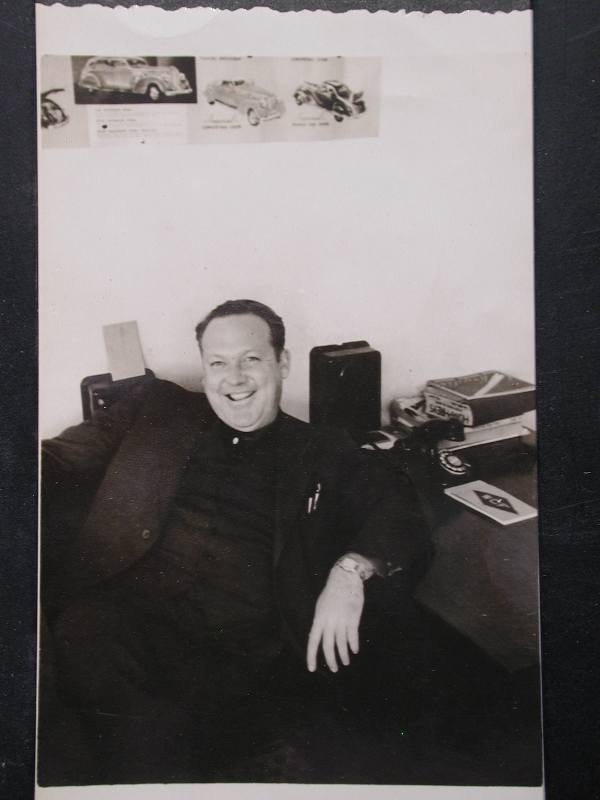 |
Kansas City Mo, Police
department
|
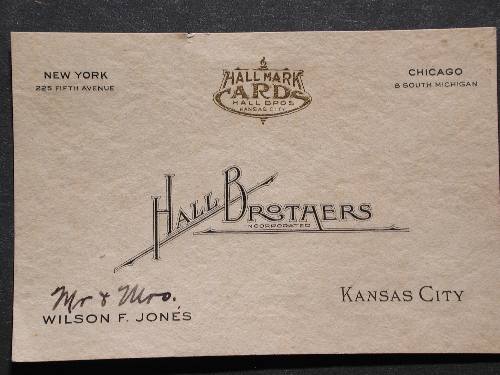 |
This was his own Chrysler dealership |
|
WW2 |
A SIDEBAR ABOUT SHERIFF JONES, FJ's father... At the time of his marriage to Jennie Hart ( of the Hart House at Old Shawnee Town) he was Sheriff of Johnson County. He was also a County commissioner for 12 years. He was a farmer and auctioneer. as commissioner he was responsible for one of the most modern roads in Johnson County, KC - Olathe road, which follows what is now Southwest Blvd from KC, to Johnson Drive in Merriam, to Nieman road in Shawnee, south to 75th street, west to Quivira Road, south through Lenexa city center and on to Olathe, the road was made of brick. laid by hand ! Link His Farm was located at 67th to 71st Street, between Nieman & Quivira, Now Shawnee Village, this was not far from his wife's parent's farm, the first location of the "Hart House",, 75th and Quivira Rd.. that house was moved to Old Shawnee Town, and is now know as the "Truck Farm". A travesty, and loss of true Shawnee history .. |
AB,, Arnold Barta -
Cedar Rapids Iowa -- This biography by his
grandson Keith is very interesting reading, a little long
but give it a chance, and you will find it interesting.